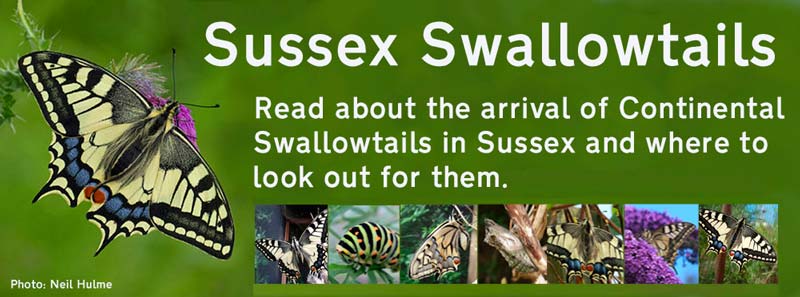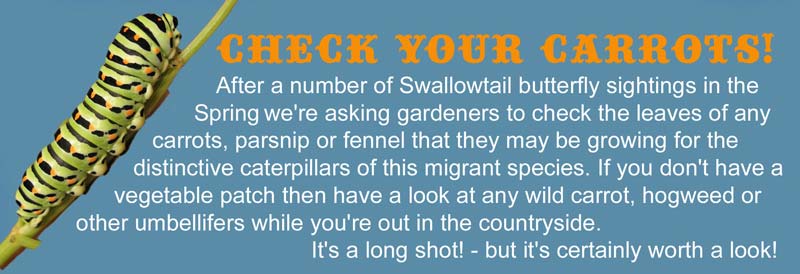
2013 saw the arrival of a small number of migrant Swallowtails into Sussex from the near continent. Members of Sussex Butterfly Conservation kept a look out for this beautiful butterfly and amazingly along with reports of adult butterflies we also received reports of egg-laying females and caterpillars in gardens across the county. With the kind co-operation of the garden owners we were fortunate to be able to monitor the progress of 13 of these caterpillars as they pupated in the autumn and tried to make it through the wet winter of 2013/14.
In May and June of 2014 adult 7 Swallowtails have emerged from the pupae we have been monitoring - and other Swallowtails have also been seen across the county on the coast, the South Downs and as far north as Horsham.
The Swallowtail (Papilio machaon) has an extensive worldwide distribution and can be found in Europe, North Africa, Asia and North America. There are 37 different subspecies found across the globe. Our ‘British’ subspecies of the Swallowtail (ssp. britannicus) is confined to the fens of Norfolk. It’s smaller and darker than the Swallowtails you’ll find just across The Channel which belong to the subspecies gorganus - the ‘Continental’ Swallowtail. There are other differences too. British swallowtail caterpillars feed solely on Milk-parsley whereas Continental Swallowtails aren’t so fussy and their caterpillars will feed on many common wild umbellifers such as Wild Carrot, Angelica and Hogweed and cultivated garden plants such as Carrot and Fennel. Unlike the British Swallowtails which don’t disperse from their Norfolk home their southern Continental cousins are strongly migratory and can make it to the far north of Europe each year. Sometimes, if we’re lucky, a few of these migrants take a wrong turn at Belgium and end up in Sussex. So here in Sussex we have two options for Swallowtail spotting; head to Norfolk or sit tight in Sussex for that one-in-a-million chance that destiny sends a Swallowtail your way.
The amazing story of the arrival of the Swallowtails was told in our full colour 2013 Annual Report (free to all our members). But the Sussex Swallowtail story continues with the offspring of last year’s butterflies now emerging in the county. This first brood of Continental Swallowtails flies in May and June. If any of them meet, mate and lay eggs their caterpillars will be seen in June and July and their adult offspring will be seen in a a second brood in late July and August. And if we have another hot summer these Sussex-born Swallowtails could be joined by more immigrants arriving from the Continent. We may well see more Swallowtails attempting to get through a British winter again in 2014/15. Could this be the start of their colonisation of the South of England? - or will the invasion fizzle out?
Where to look for Swallowtails
We’re keen to receive any records of Continental Swallowtails so keep an eye out - and your camera handy - when you’re out and about anywhere in Sussex over the summer. In 2013 most of the Swallowtails were restricted to the South of Sussex and lucky folk saw them in their gardens in Shoreham, Peacehaven, Southwick, Hastings and Eastbourne. So if you live along the South coast check any buddleia you pass by. Swallowtails are famous for their ‘hill-topping’ behaviour; males congregate on the top of hills and compete for females. Recent Sussex records have indeed been from some of our highest summits at Chanctonbury Ring, Whiteways Roundabout, Windover Hill and Firle Beacon. The river valleys of Sussex are also known to ‘channel’ incoming migrants. So searching around the Cuckmere, Ouse, Adur and Arun could be rewarding.

Also, check your gardens and allottments. Fennel leaves and Carrot tops are the foodplants of the Swallowtails distinctive stripey caterpillars. If you find any caterpillars over the coming months please send us a photo. And if you haven’t got any carrots in your garden now’s the time to plant them. If you don’t attract any egg-laying Swallowtails you’ll at least have something to stick into your shepherds pie. The caterpillars can be confused with the Mullien moth caterpillar - so check out an image of that caterpillar if you’re not sure
Send any sightings and photos in to our sightings page at: sighting@sussex-butterflies.org.uk.
